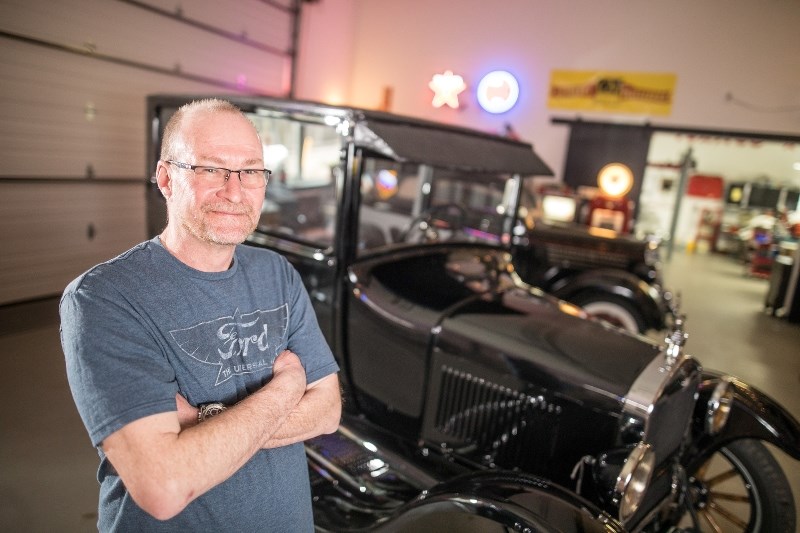Bouncing around in a Tin Lizzie may not be the most comfortable ride, but it definitely gets attention.
Members of the Foothills Model T Ford Club are reliving an important piece of North American automotive history every time they hit the road in their refurbished Henry Ford Model Ts.
“Even though it’s a car, in essence it’s a motorized horse,” said Chris Carroll, who owns a 1927 Model T. “Henry’s intent was to make a car everyone could afford. For that to happen it was very much a base model car. They’ve got wooden floors, no turn signals, there is really nothing to them but a motor and very little for braking. To me it was a fascinating piece of history.”
The Model T was built by the Ford Motor Company from 1908 until 1927 in an assembly-line production. In Canada, it was produced in Walkerville, Ont., independent from the American company, but relied on American engineering and design.
At times, the Model T comprised as much as 40 per cent of all cars sold in the United States.
Constructed with no gas pedal, the Model T is always in gear. Carroll said the left pedal changes gears, the centre pedal reverses the car and the right pedal is the transmission break.
“Every time you get into the vehicle you have to sit there for a minute and remember how to drive this thing because it’s completely foreign,” he said. “Spending 10 hours bouncing around in a model T is not all that comfortable. The suspension is like a buggy so there’s a constant left to right bouncing. Spending a day in a Model T is an adventure.”
Carroll worked with vintage cars for two decades before he bought his 1927 model.
“I did a full seven-year restoration on the car,” he said. “It’s better than it was when it rolled off the assembly line.”
The Foothills Model T Ford Club consists of about 100 member families across southern Alberta who own more than 200 Model Ts in total.
“It’s a fading interest,” Carroll said. “The younger generation isn’t interested in driving these things because they go 30 to 40 miles an hour.”
This wasn’t a deterrent for Les Schubert, who joined the club in 1974 – two years after its inception – after buying a 1927 Roadster in Manitoba.
He fell in love with the Roadster the minute he saw it, and now owns five Model Ts.
“I was fascinated by the Model T,” he said. “It was the car that basically put the world on wheels. In many ways it was so much easier to own and maintain than anything else that was made at the time.”
What Schubert finds interesting about the cars is many models were built as right-hand drives.
“People don’t know that up to and including 1917 in British Columbia they drove on the other side of the road,” he said. “When they started building highways across the mountains B.C. switched to the other side. Prior to 1913 the majority of cars built in North America were right-hand drive. People drove horses sitting on the right, so it was natural to sit on the right to drive a car.”
The Model T was available in several body styles including a seven-seat town car, five-seat touring car and two-seat runabout. The cars were only available in black from 1914 to 1926 due to the low cost and durability of black paint.
The engine generated 20 horsepower and propelled the car to top speeds of 70 km/h. In most models the engine was started by a hand crank, but after 1920 some were equipped with battery-powered starters.
While the Model T was considered a simple, reliable, rugged car in its day, operating on four cylinders, Schubert said it’s much more complicated for today’s drivers.
“It was a steep learning curve,” he said. “It took me a year to get it on the road and I’ve had fun with it ever since.”
Schubert, a mechanical engineer, said he loves getting behind the wheel of his Model Ts. He put 2,500 miles on his 1913 Model T touring car driving in B.C. for 15 days.
“Every drive is a parade and every stop is a car show,” he said. “People are fascinated by it. They’re curious.”
Schubert spends a lot of time refurbishing the cars, doing the mechanical and metal work himself and getting the upholstery and painting done by a professional.
“The fast moving parts are readily available,” he said. “It’s amazing what you can buy brand new. Some body parts are hard to get, some are easy to get. Then you get into specialty parts that are tricky to get.”
Back in its day, 15 million Model T Fords were produced in the United States and one million in Canada, said club president Ross Benedict. The price ranged from than $825 in 1909 to under $300 in the mid 1920s.
“(Henry Ford) tried to make the vehicles affordable to the masses so anybody and everybody could have them,” said Benedict.
The only model of car produced more than the Model T Ford is the Volkswagen Beetle, he said.
“They just kept modifying and improving it,” he said of the Model T. “Later models had better brakes, more comfortable seating, things like that. Very early ones were buckboard with motors.”




.png;w=120;h=80;mode=crop)